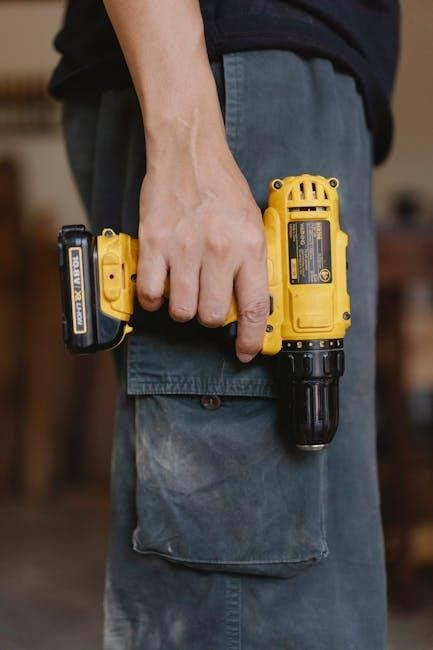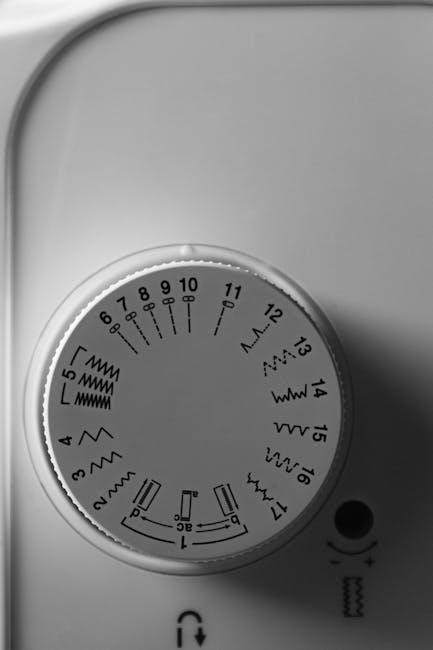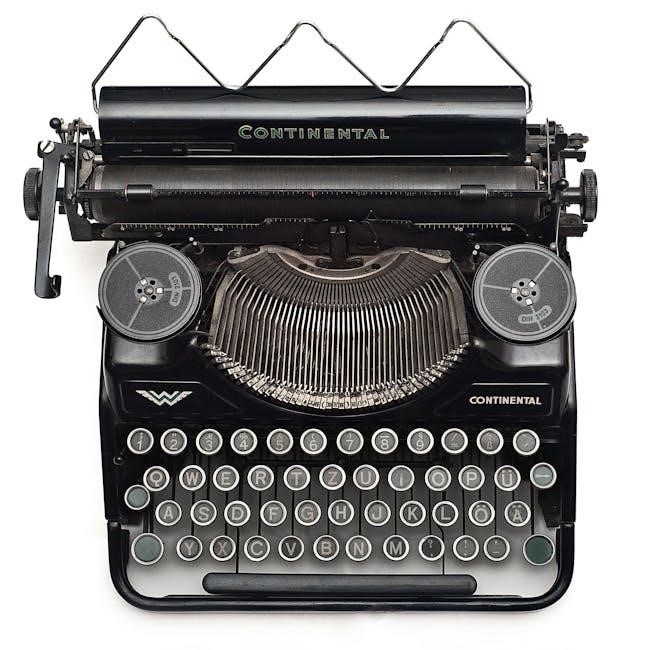Welcome to the Carrier 19XR manual. This guide provides essential information for installing, operating, and maintaining AquaEdge and EVERGREEN 19XR chillers, ensuring optimal performance and compliance with industry standards.
1.1 Overview of the Carrier 19XR Chiller
The Carrier 19XR chiller is a high-performance, water-cooled unit designed for commercial and industrial HVAC applications. It features advanced technologies like the AquaEdge and EVERGREEN systems, ensuring energy efficiency and reliability. The chiller is built with a semi-hermetic, two-stage centrifugal design, offering robust performance and durability. It is suitable for various cooling needs, from small facilities to large industrial plants. The 19XR model is known for its compliance with industry standards and safety protocols, making it a trusted choice for professionals. This overview provides a foundational understanding of the chiller’s capabilities and design, preparing users for detailed installation, operation, and maintenance guidelines found in subsequent sections of the manual.
1.2 Importance of the Manual for Users
The Carrier 19XR manual is an essential resource for users, providing detailed guidance on installation, operation, and maintenance. It ensures safe and efficient use of the chiller, covering critical aspects like initial start-up, routine maintenance, and troubleshooting. The manual also outlines safety precautions and compliance with industry standards, protecting both the equipment and the user. By following the manual, users can optimize the chiller’s performance, reduce energy consumption, and extend its lifespan. It serves as a comprehensive reference, addressing common issues and offering solutions to minimize downtime. Whether for technicians or facility managers, the manual is indispensable for maximizing the 19XR’s capabilities and ensuring reliable operation.
Product Overview
The Carrier 19XR manual covers the AquaEdge and EVERGREEN 19XR chillers, detailing their advanced features, efficient performance, and user-friendly design for optimal cooling solutions in various applications.

2.1 AquaEdge 19XR Chiller Features
The AquaEdge 19XR chiller is designed for high efficiency and reliability, featuring advanced cooling technologies. It includes a semi-hermetic two-stage centrifugal compressor, ensuring optimal performance across various load conditions. The chiller is built with durable materials and incorporates smart controls for precise temperature management. Its compact design minimizes space requirements while maintaining high capacity. The AquaEdge 19XR also boasts low noise operation, making it suitable for urban environments. Additionally, it is designed to comply with environmental regulations, using eco-friendly refrigerants. The system’s advanced monitoring capabilities allow for real-time performance tracking, enhancing energy efficiency and reducing operational costs. These features make the AquaEdge 19XR a versatile and reliable choice for commercial and industrial cooling needs.
2.2 EVERGREEN 19XR User Manual Highlights
The EVERGREEN 19XR user manual is a comprehensive guide designed to help users optimize the performance of their chiller. It includes detailed installation instructions, start-up procedures, and maintenance schedules. The manual emphasizes safety protocols, such as proper refrigerant handling and emergency shutdown procedures. Key sections cover troubleshooting common issues, ensuring users can address problems efficiently. Additionally, the manual highlights energy-saving features and operational best practices. It also provides technical specifications and compliance information, ensuring adherence to industry standards. By following the manual, users can extend the lifespan of their chiller and maintain peak efficiency. The EVERGREEN 19XR manual is an essential resource for both new and experienced operators, offering clear guidance for every aspect of chiller operation and maintenance.
Key Features and Technical Specifications
The Carrier 19XR chiller features advanced energy efficiency, compact design, and compliance with industry standards, ensuring reliable performance and environmental sustainability in various applications.
3.1 Design and Performance Capabilities
The Carrier 19XR chiller is designed for high efficiency and reliability, featuring advanced technologies like variable-speed drives and optimized heat exchangers. Its compact design allows for easy installation in various spaces while maintaining superior performance. The chiller’s design ensures minimal energy consumption, making it an environmentally friendly option. With a focus on durability, the 19XR model incorporates robust materials and innovative engineering to withstand demanding operational conditions. Its performance capabilities include precise temperature control, adaptability to changing load requirements, and quiet operation. These features make the 19XR an ideal choice for commercial and industrial cooling applications, aligning with modern sustainability goals and industry standards. The chiller’s design and performance capabilities are further enhanced by Carrier’s commitment to innovation and customer satisfaction.
3.2 Compliance with Industry Standards
The Carrier 19XR chiller is designed to meet stringent industry standards, ensuring reliability, safety, and environmental compliance. It adheres to ASHRAE and AHRI regulations, guaranteeing optimal performance and energy efficiency. The chiller’s design incorporates eco-friendly refrigerant solutions, aligning with global sustainability initiatives. Compliance with industry standards is evident in its low noise operation, minimal refrigerant usage, and adherence to safety protocols. The 19XR model undergoes rigorous testing to ensure it meets or exceeds industry benchmarks for cooling capacity and energy consumption. By complying with these standards, the Carrier 19XR chiller provides users with a trusted solution for commercial and industrial cooling needs, while also supporting environmental goals. This compliance ensures the chiller operates efficiently and safely, making it a reliable choice for diverse applications.

Installation Instructions
Follow detailed guidelines for proper installation, ensuring compliance with safety protocols and efficiency standards. Refer to the manual for specific piping, wiring, and start-up procedures.
4.1 Pre-Installation Checks and Requirements
Before installing the Carrier 19XR chiller, ensure the site is prepared and meets all specifications. Inspect the piping for leaks and damage, and verify that all connections are secure. Check that the refrigerant type matches the chiller’s design specifications to avoid malfunctions. Ensure electrical connections comply with local codes and the chiller’s requirements. Review the Carrier System Design Manual for piping techniques and guidelines. Verify that all safety precautions are in place, such as proper ventilation and emergency shutdown procedures. Ensure the chiller is level and anchored securely to prevent vibration. Finally, record the unit’s serial number for future reference and warranty purposes. These steps ensure a safe and efficient installation process.
4.2 Piping and Wiring Guidelines
Proper piping and wiring are critical for the safe and efficient operation of the Carrier 19XR chiller. Refer to the Carrier System Design Manual for detailed piping techniques and guidelines. Ensure all piping connections are secure and free from leaks. Verify that the refrigerant type matches the chiller’s design specifications to prevent damage or malfunction. For wiring, follow local electrical codes and ensure all connections are correctly routed and insulated. Note that wiring diagrams may not include optional devices such as remote start-stop controls. Double-check that all electrical components are properly grounded and that circuit breakers are appropriately sized. Adhere to these guidelines to ensure a safe and efficient installation, and consult the manual for specific recommendations on remote start-stop wiring configurations.
4.3 Initial Start-Up Checklist
Before starting the Carrier 19XR chiller, complete the initial start-up checklist to ensure safe and proper operation. Verify all electrical connections are secure and meet local codes. Check refrigerant levels and ensure the correct type is used to avoid damage. Inspect water flow rates and pressures to match design specifications. Test all safety controls and alarms to confirm they function correctly. Review the piping connections for leaks and proper insulation. Ensure the chiller is properly grounded and all circuit breakers are correctly sized. Refer to the Carrier System Design Manual for specific start-up procedures. Document all findings and address any issues before full operation. This checklist helps prevent malfunctions and ensures a smooth start-up process. Always follow safety guidelines and consult the manual for detailed instructions.

Operation and Control
The Carrier 19XR chiller operates efficiently across various modes, with advanced control systems ensuring precise temperature management and energy savings. Monitoring performance is straightforward via user-friendly interfaces.
5.1 Operating Modes and Efficiency
The Carrier 19XR chiller offers multiple operating modes to optimize performance and energy efficiency. It excels in part-load conditions, reducing energy consumption while maintaining precise temperature control. Advanced control systems enable seamless transitions between modes, ensuring consistent operation. The chiller’s design incorporates variable-speed drives and optimized compressors, contributing to higher efficiency levels. These features not only minimize energy usage but also reduce operational noise, making it suitable for various applications. By leveraging cutting-edge technology, the 19XR chiller delivers exceptional efficiency, lowering operational costs and environmental impact. Regular monitoring and adjustments can further enhance its performance, ensuring it operates at peak efficiency under all conditions. This makes the 19XR a reliable choice for demanding cooling requirements.
5.2 Control Systems and Interfaces
The Carrier 19XR chiller features advanced control systems designed to optimize performance and user experience. The intuitive interface provides real-time monitoring and precise control over operational parameters, enabling efficient management of cooling systems. Remote monitoring capabilities allow users to access chiller performance data and adjust settings from a centralized location. The system integrates seamlessly with building management systems (BMS), ensuring comprehensive control and energy efficiency. User-friendly displays and interfaces simplify navigation, while advanced algorithms continuously optimize chiller operation. These control systems are designed to maximize efficiency, reduce energy consumption, and provide reliable performance under varying load conditions. By leveraging cutting-edge technology, the 19XR chiller offers unparalleled control and flexibility for modern cooling demands.
5.3 Monitoring and Adjusting Performance
Monitoring and adjusting the performance of the Carrier 19XR chiller is crucial for maintaining optimal efficiency and reliability. The system provides real-time data on operational parameters, such as temperature, pressure, and flow rates, allowing users to identify trends and potential issues. Advanced sensors and monitoring tools enable precise adjustments to be made, ensuring the chiller operates within desired ranges. The user-friendly interface allows for easy navigation and customization of settings, while automated alerts notify operators of deviations from setpoints. Regular performance checks and adjustments can prevent inefficiencies and extend equipment lifespan. By leveraging these monitoring capabilities, users can fine-tune the chiller’s operation to meet specific cooling demands, ensuring consistent performance and energy savings. This proactive approach helps maintain peak efficiency and minimizes downtime, making it essential for effective chiller management.

Maintenance and Troubleshooting
Regular maintenance ensures optimal performance and extends the chiller’s lifespan. Troubleshooting common issues promptly prevents downtime and maintains efficiency. Follow guidelines for best results.
6.1 Routine Maintenance Tasks

Regular maintenance is crucial for ensuring the Carrier 19XR chiller operates efficiently and reliably. Key tasks include checking refrigerant levels, inspecting piping for leaks, and verifying proper wiring connections. Ensure all components are clean and free from debris. Refer to the Carrier System Design Manual for detailed piping guidelines. Routine inspections help prevent potential issues and extend the system’s lifespan. Always follow the initial start-up checklist to ensure proper operation after maintenance. Compliance with industry standards is essential for safety and performance. By adhering to these tasks, users can maintain optimal chiller functionality and minimize downtime. Proper maintenance also ensures environmental compliance and energy efficiency, aligning with Carrier’s commitment to quality and reliability.
6.2 Troubleshooting Common Issues
Troubleshooting the Carrier 19XR chiller involves identifying and addressing common issues promptly to ensure optimal performance. Start by reviewing the initial start-up checklist to verify proper installation and operation. Check for refrigerant leaks, as improper levels can cause malfunctions. Inspect piping connections and wiring for damage or loose connections, as these can lead to operational disruptions. Refer to the Carrier System Design Manual for detailed piping techniques and guidelines. If issues persist, consult the EVERGREEN 19XR user manual for specific troubleshooting steps. Always follow safety precautions, such as turning off power before performing repairs. Regular maintenance tasks, like cleaning components and checking for debris, can prevent many common problems. By addressing issues early, users can minimize downtime and ensure the chiller operates efficiently and safely.
6.3 Refrigerant Handling and Safety
Proper refrigerant handling and safety are critical when working with the Carrier 19XR chiller. Always follow industry guidelines and manufacturer recommendations to avoid accidents. Wear personal protective equipment, including gloves and safety glasses, when handling refrigerants. Ensure the area is well-ventilated to prevent inhalation of refrigerant vapors. Never mix refrigerants, as this can cause system damage or malfunction. In case of a refrigerant leak, evacuate the area and refer to emergency procedures outlined in the manual. Properly dispose of refrigerants and related materials in compliance with environmental regulations. For detailed instructions, consult the Carrier System Design Manual. Adhering to these safety protocols ensures the longevity of the chiller and protects both personnel and the environment.

Safety Considerations
Safety is paramount when working with the Carrier 19XR chiller. Always follow safety protocols, wear protective equipment, and adhere to industry standards to prevent accidents and ensure compliance.

7.1 General Safety Precautions
When working with the Carrier 19XR chiller, it is crucial to follow general safety precautions to ensure the well-being of personnel and the integrity of the equipment. Always wear appropriate personal protective equipment, including safety glasses, gloves, and a hard hat, when performing maintenance or repairs. Ensure the chiller is properly de-energized before starting any work to prevent electrical shocks or accidents. Avoid using unauthorized tools or equipment, as they may damage the system or pose a safety risk. Keep the area around the chiller clean and clear of obstructions to prevent tripping hazards. Never introduce unauthorized refrigerants, as this can cause system damage or malfunction. Refer to the Carrier System Design Manual for specific guidelines on handling refrigerants safely. Adherence to these precautions ensures compliance with industry standards and minimizes potential risks during operation and maintenance.
7.2 Emergency Procedures and Protocols
In the event of an emergency involving the Carrier 19XR chiller, it is essential to follow established protocols to ensure safety and minimize damage. If a refrigerant leak occurs, immediately evacuate the area, ventilate the space, and shut off the chiller. Do not re-enter the area until it has been deemed safe by trained personnel. In case of electrical issues, disconnect power to the unit and contact a qualified technician. For system malfunctions, refer to the troubleshooting section of the manual. Always prioritize personal safety and avoid attempting repairs without proper training. Keep emergency contact information readily available, including Carrier customer support. Regular training on emergency procedures ensures preparedness and compliance with industry safety standards. Adherence to these protocols helps protect both personnel and equipment during critical situations.
Additional Resources
For further guidance, refer to the Carrier System Design Manual and explore customer support options for detailed assistance with the 19XR chiller.

8.1 Carrier System Design Manual

The Carrier System Design Manual is a comprehensive resource for designing and optimizing chiller systems, including the 19XR model. It provides detailed guidelines for piping techniques, wiring, and system integration, ensuring compliance with industry standards. This manual is essential for engineers and technicians to maximize the performance and efficiency of the AquaEdge 19XR chiller. It also offers insights into troubleshooting common issues and maintaining optimal system operation. By following the manual’s recommendations, users can ensure their chiller systems meet local regulations and operate safely. The Carrier System Design Manual is a valuable companion to the EVERGREEN 19XR user manual, offering advanced technical details for complex installations and maintenance tasks.
8.2 Customer Support and Service Options
Carrier offers comprehensive customer support and service options to ensure optimal performance of the 19XR chiller. Users can access dedicated support teams for technical assistance, troubleshooting, and maintenance guidance. The Carrier Network provides resources such as manuals, training materials, and FAQs to help users resolve issues quickly. Additionally, Carrier offers on-site service options, including routine maintenance and emergency repairs, to minimize downtime. Customers can also utilize online portals for parts ordering and service scheduling. With a focus on customer satisfaction, Carrier ensures that 19XR users receive timely and reliable support, enhancing their overall experience with the product. These services are designed to maximize efficiency, safety, and system longevity, making Carrier a trusted partner for chiller solutions.






































































